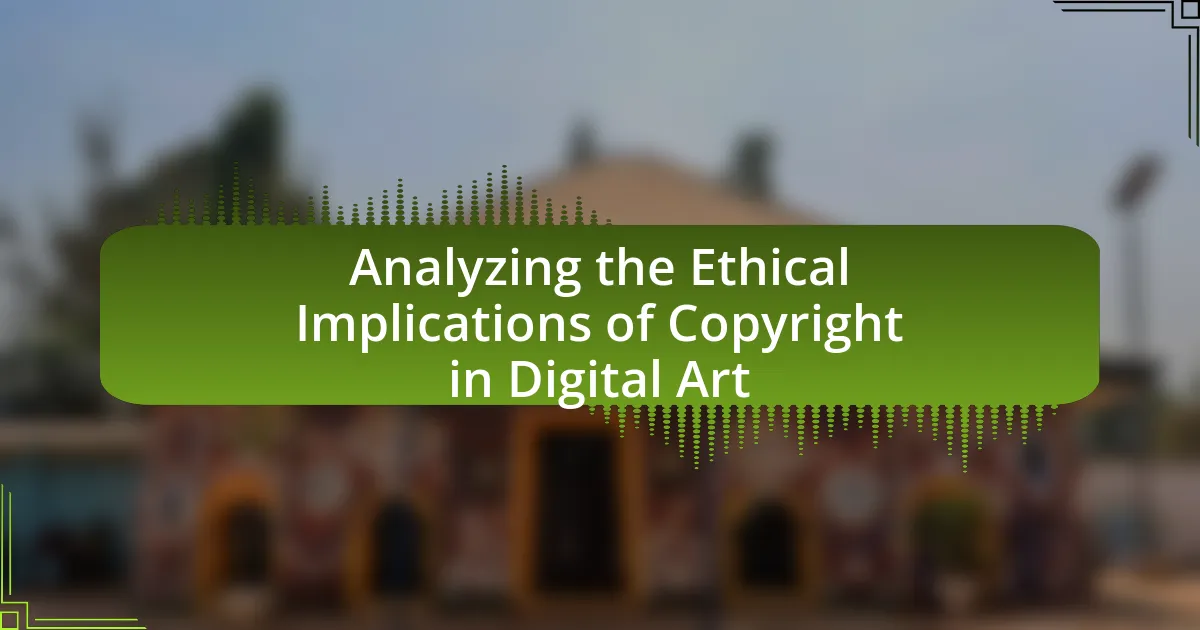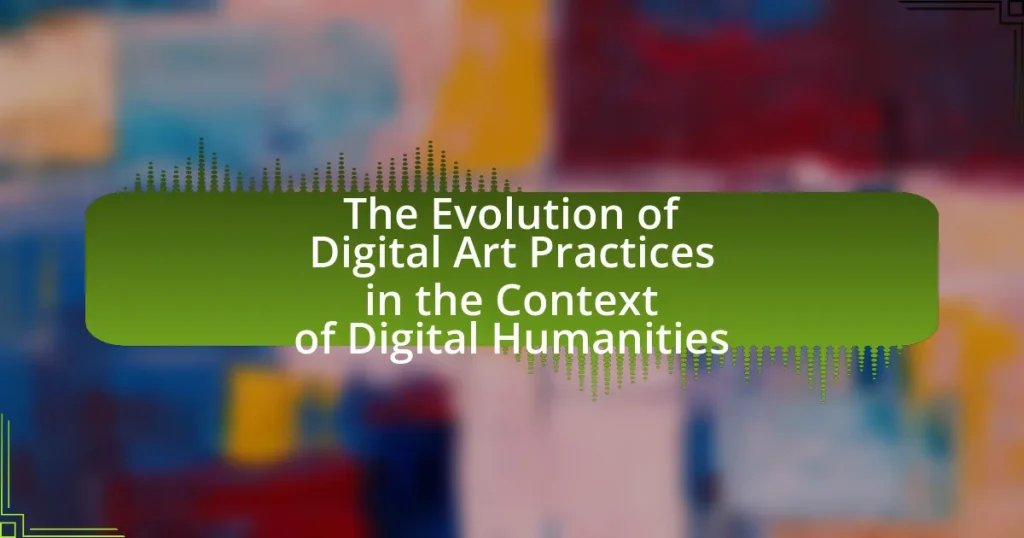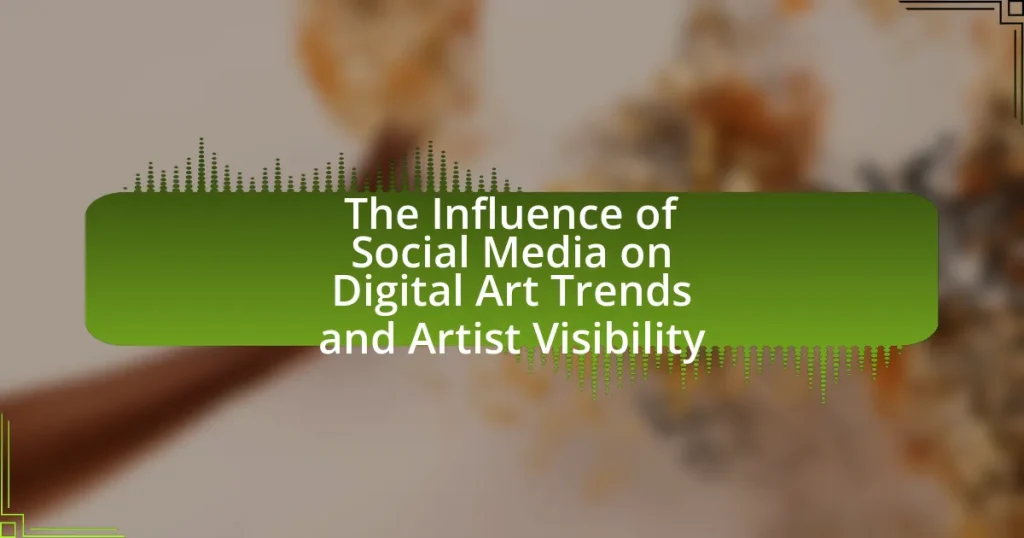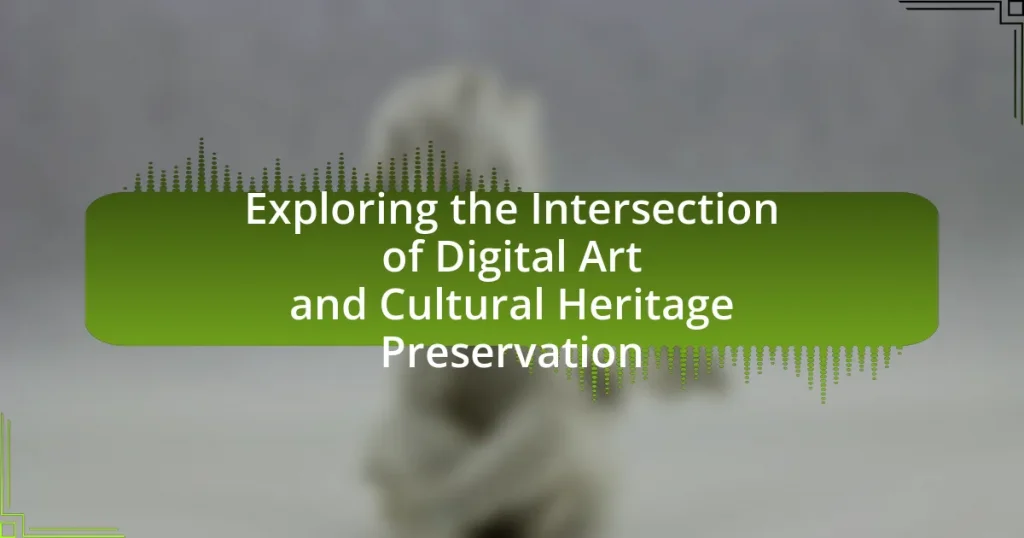The article examines the ethical implications of copyright in digital art, focusing on the balance between protecting artists’ rights and promoting creativity. It outlines how copyright law applies to digital art, including key components such as originality and fixation, and discusses the variations in copyright laws across different jurisdictions. The article highlights the importance of copyright for digital artists, the challenges they face regarding unauthorized use, and the ethical dilemmas that arise from issues of originality and fair use. Additionally, it explores future trends, including the impact of technology, blockchain, and artificial intelligence on copyright issues, while providing best practices for artists to navigate these complexities.
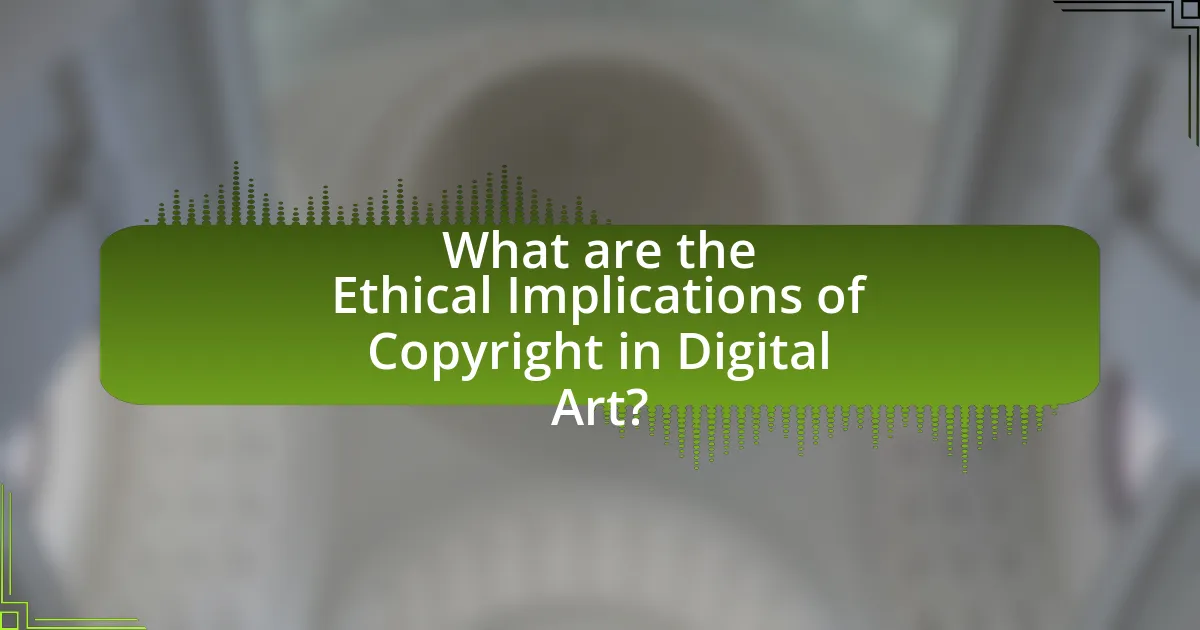
What are the Ethical Implications of Copyright in Digital Art?
The ethical implications of copyright in digital art primarily revolve around the balance between protecting artists’ rights and fostering creativity. Copyright laws aim to safeguard the intellectual property of artists, ensuring they receive recognition and compensation for their work. However, these laws can also stifle innovation and collaboration, as they may restrict the ability of other creators to build upon existing works. For instance, the rise of remix culture highlights the tension between original creators and those who wish to reinterpret or transform existing art. Additionally, the enforcement of copyright can lead to issues of accessibility, where the high costs associated with licensing can limit the public’s engagement with art. Thus, while copyright serves to protect artists, it also raises ethical questions about the implications for creativity, access, and cultural exchange in the digital age.
How does copyright law apply to digital art?
Copyright law protects digital art as original works of authorship, granting creators exclusive rights to reproduce, distribute, and display their creations. This legal framework applies to digital art in the same way it does to traditional art forms, ensuring that artists maintain control over their work and can prevent unauthorized use. The U.S. Copyright Office states that copyright protection is automatic upon the creation of a work, provided it is fixed in a tangible medium, which includes digital formats. This means that digital artists can enforce their rights against infringement, such as unauthorized copying or distribution of their art online.
What are the key components of copyright law relevant to digital art?
The key components of copyright law relevant to digital art include originality, fixation, and the rights of the creator. Originality requires that the digital artwork must be an independent creation that exhibits a minimal degree of creativity. Fixation mandates that the artwork must be captured in a tangible medium, such as a digital file, to qualify for copyright protection. The rights of the creator encompass exclusive rights to reproduce, distribute, and display the work, as established by the U.S. Copyright Act of 1976, which provides legal protection for original works of authorship, including digital art. These components ensure that artists maintain control over their creations and can benefit from their work in the digital marketplace.
How do copyright laws differ across various jurisdictions for digital art?
Copyright laws for digital art vary significantly across jurisdictions, primarily due to differences in legal frameworks and cultural attitudes towards intellectual property. For instance, in the United States, copyright protection is automatic upon creation, allowing artists to control reproduction and distribution, while in the European Union, the concept of moral rights grants artists additional protections, such as the right to attribution and the right to object to derogatory treatment of their work. Furthermore, countries like Japan have unique provisions that emphasize the importance of both economic and moral rights, reflecting their cultural values. These variations can lead to complexities in enforcement and rights management for digital artists operating internationally, as they must navigate differing regulations and potential legal challenges in each jurisdiction.
Why is copyright important for digital artists?
Copyright is important for digital artists because it protects their original works from unauthorized use and reproduction. This legal protection ensures that artists retain control over their creations, allowing them to benefit financially from their art. According to the U.S. Copyright Office, copyright grants the creator exclusive rights to reproduce, distribute, and display their work, which is crucial in a digital landscape where art can be easily copied and shared. Without copyright, digital artists face the risk of losing recognition and income, as their work could be exploited without their consent.
What protections does copyright provide to digital artists?
Copyright provides digital artists with exclusive rights to their original works, including the right to reproduce, distribute, and display their creations. This legal protection ensures that artists can control how their art is used and prevents unauthorized use or reproduction by others. According to the U.S. Copyright Office, copyright protection is automatic upon the creation of a work, meaning digital artists do not need to register their work to receive these rights, although registration can enhance enforcement options. This framework is crucial for safeguarding the economic interests of digital artists and fostering creativity in the digital landscape.
How does copyright influence the creative process for digital artists?
Copyright significantly influences the creative process for digital artists by establishing legal protections for their original works, which encourages innovation and creativity. This legal framework allows artists to control the use of their creations, ensuring they receive recognition and financial compensation for their efforts. For instance, the U.S. Copyright Act of 1976 grants creators exclusive rights to reproduce, distribute, and display their works, which incentivizes artists to produce new content without the fear of unauthorized use. Additionally, copyright fosters a sense of ownership that can motivate artists to explore new ideas and techniques, knowing their intellectual property is safeguarded.
What challenges do digital artists face regarding copyright?
Digital artists face significant challenges regarding copyright, primarily due to the ease of reproduction and distribution of digital works. This environment increases the risk of unauthorized use and infringement, as digital art can be easily copied and shared online without the artist’s consent. Additionally, the ambiguity surrounding copyright laws, particularly in the digital realm, complicates the protection of artists’ rights. For instance, many artists struggle to navigate the complexities of licensing agreements and the fair use doctrine, which can lead to unintentional violations. Furthermore, the lack of awareness among consumers about copyright issues often results in the exploitation of artists’ work without proper attribution or compensation. These challenges highlight the need for clearer regulations and better education on copyright for both artists and the public.
How does digital reproduction affect copyright enforcement?
Digital reproduction complicates copyright enforcement by making it easier to copy and distribute works without authorization. The ease of duplicating digital content leads to widespread infringement, as individuals can share files instantly across various platforms. According to a 2020 report by the International Intellectual Property Alliance, digital piracy costs the U.S. economy approximately $29 billion annually, highlighting the significant impact of unauthorized reproductions on copyright holders. Additionally, the anonymity of the internet makes it challenging for copyright owners to track and pursue infringers effectively, further undermining enforcement efforts.
What are the implications of copyright infringement for digital artists?
Copyright infringement for digital artists can lead to significant legal and financial consequences. When a digital artist’s work is used without permission, they may face loss of income due to unauthorized reproductions or sales of their art. Additionally, artists may incur legal costs if they choose to pursue litigation against infringers, which can be both time-consuming and expensive. According to the U.S. Copyright Office, copyright infringement can result in statutory damages ranging from $750 to $30,000 per work, and in cases of willful infringement, damages can be as high as $150,000. This financial risk underscores the importance of protecting one’s intellectual property in the digital space.
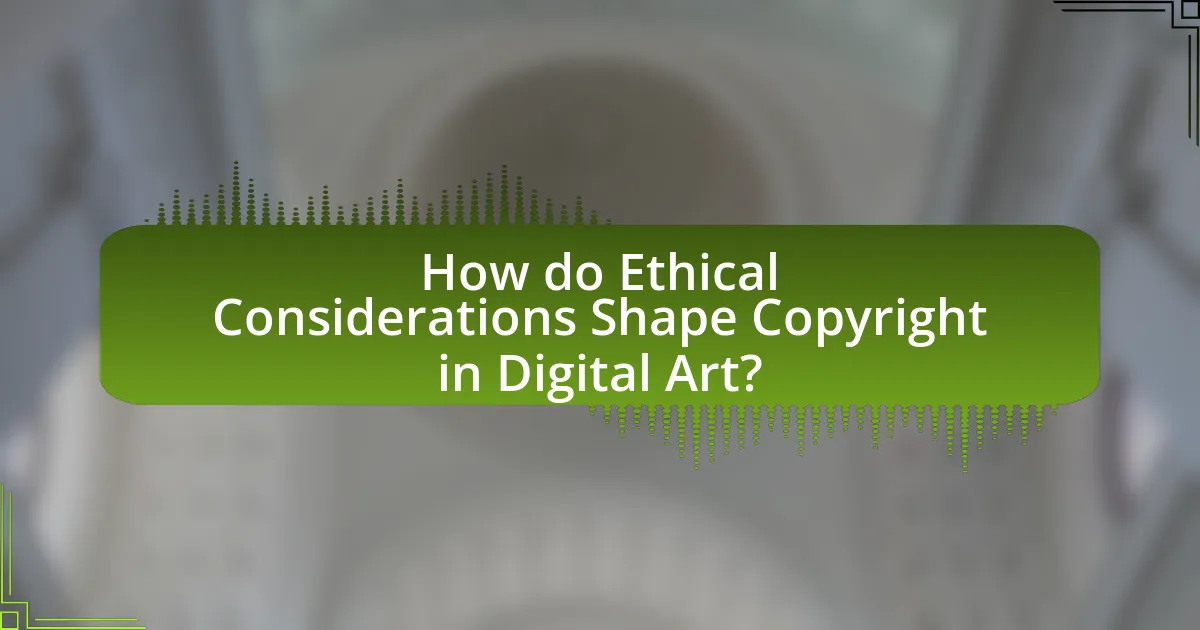
How do Ethical Considerations Shape Copyright in Digital Art?
Ethical considerations significantly shape copyright in digital art by influencing the balance between protecting creators’ rights and promoting public access to art. These considerations include the moral rights of artists, which emphasize the importance of attribution and integrity of the work, as established in the Berne Convention for the Protection of Literary and Artistic Works. Additionally, ethical debates surrounding fair use and transformative use impact how digital art is shared and reused, as seen in cases like Cariou v. Prince, where the court ruled on the transformative nature of derivative works. Such ethical frameworks guide legislation and inform practices within the digital art community, ensuring that copyright laws evolve to reflect societal values regarding creativity and ownership.
What ethical dilemmas arise from copyright in digital art?
Copyright in digital art presents ethical dilemmas such as the balance between protecting artists’ rights and fostering creativity. Artists often face challenges when their work is used without permission, leading to potential financial loss and undermining their creative efforts. Conversely, the ease of sharing and remixing digital art raises questions about fair use and the extent to which derivative works can be created without infringing on original copyrights. Additionally, the anonymity of the internet complicates the enforcement of copyright laws, making it difficult for artists to claim ownership and seek redress for unauthorized use. These dilemmas highlight the tension between individual rights and collective creativity in the digital landscape.
How do issues of originality and inspiration impact ethical considerations?
Issues of originality and inspiration significantly impact ethical considerations by influencing the boundaries of intellectual property rights and the moral responsibilities of creators. Originality is often a criterion for copyright protection, meaning that works must demonstrate a certain level of uniqueness to qualify for legal safeguards. When inspiration leads to derivative works, ethical dilemmas arise regarding the extent to which an artist can draw from existing creations without infringing on the rights of the original creator. For instance, the U.S. Copyright Office stipulates that a work must be original and fixed in a tangible medium to be protected, which raises questions about the fine line between inspiration and plagiarism. Furthermore, ethical considerations are heightened when artists fail to credit or compensate original creators, leading to debates about fairness and respect within the artistic community.
What role does fair use play in the ethical landscape of digital art?
Fair use serves as a critical component in the ethical landscape of digital art by allowing artists to incorporate existing works without seeking permission, thereby fostering creativity and innovation. This legal doctrine enables artists to use portions of copyrighted material for purposes such as criticism, comment, news reporting, teaching, scholarship, or research, which can enhance the transformative nature of their work. For instance, the case of Campbell v. Acuff-Rose Music, Inc. established that transformative use is a key factor in determining fair use, emphasizing that new expressions can coexist with original works. This legal framework supports the argument that digital artists can ethically engage with existing art, provided their use meets the criteria of fair use, thus promoting a more dynamic and diverse artistic community.
How can digital artists navigate ethical copyright issues?
Digital artists can navigate ethical copyright issues by understanding copyright laws, seeking permission for using others’ works, and utilizing licenses that clarify usage rights. Knowledge of copyright laws, such as the Berne Convention, which protects original works automatically upon creation, is essential for artists to safeguard their creations. Additionally, artists should obtain explicit permission when incorporating elements from other creators’ works to avoid infringement. Utilizing Creative Commons licenses allows artists to share their work while specifying how it can be used, thus promoting ethical practices. These strategies help digital artists respect intellectual property rights while fostering a collaborative creative environment.
What best practices should digital artists follow to respect copyright?
Digital artists should always create original work and obtain permission for any use of copyrighted materials. This includes understanding and adhering to copyright laws, which protect the rights of creators and their works. Artists must also credit sources when using others’ work, even if it is modified, to acknowledge the original creator’s contribution. Additionally, utilizing royalty-free or Creative Commons licensed materials can help ensure compliance with copyright regulations. Following these practices not only respects the rights of other artists but also fosters a culture of ethical creativity within the digital art community.
How can digital artists advocate for their rights ethically?
Digital artists can advocate for their rights ethically by educating themselves about copyright laws and actively participating in discussions about fair use and licensing. Understanding the legal framework allows artists to protect their work while respecting the rights of others. For instance, the U.S. Copyright Office provides resources that clarify how copyright applies to digital art, enabling artists to navigate their rights effectively. Additionally, joining professional organizations, such as the Graphic Artists Guild, can provide support and resources for ethical advocacy. These organizations often offer guidelines and best practices that help artists assert their rights without infringing on the rights of others, fostering a community that values ethical standards in the digital art space.
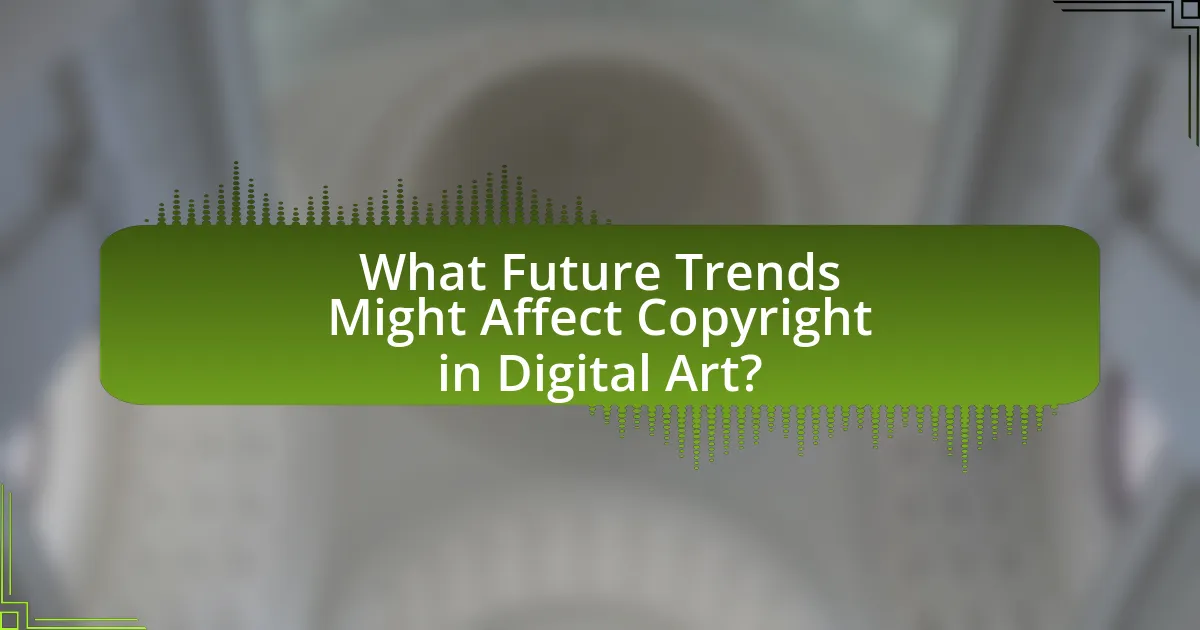
What Future Trends Might Affect Copyright in Digital Art?
Future trends that might affect copyright in digital art include the rise of artificial intelligence in art creation, the increasing use of blockchain technology for ownership verification, and evolving legal frameworks addressing digital content. The integration of AI tools allows for the generation of art that may challenge traditional notions of authorship, as AI can produce works without human intervention. Blockchain technology offers a decentralized method for artists to register their works, potentially providing more secure and transparent ownership records. Additionally, as digital art becomes more prevalent, lawmakers are likely to adapt existing copyright laws to better address the unique challenges posed by digital mediums, including issues of reproduction and distribution. These trends indicate a shift towards more complex copyright considerations in the digital art landscape.
How is technology changing the landscape of copyright in digital art?
Technology is significantly altering the landscape of copyright in digital art by enabling new methods of creation, distribution, and enforcement. Digital tools such as blockchain are providing artists with innovative ways to secure their rights and track ownership, while platforms for sharing art online have increased the risk of unauthorized use and reproduction. For instance, the rise of non-fungible tokens (NFTs) has introduced a mechanism for artists to sell their work with embedded copyright protections, allowing for royalties on secondary sales. Additionally, advancements in artificial intelligence are creating challenges in defining authorship and originality, as AI-generated art raises questions about who holds the copyright. These developments illustrate the need for evolving legal frameworks to address the complexities introduced by technology in the realm of digital art copyright.
What impact do blockchain and NFTs have on copyright issues?
Blockchain and NFTs significantly alter copyright issues by providing a decentralized and transparent method for verifying ownership and provenance of digital art. This technology enables artists to embed copyright information directly into the NFT, ensuring that their rights are preserved and easily traceable. For instance, a study by the World Intellectual Property Organization (WIPO) highlights that blockchain can help reduce copyright infringement by creating immutable records of ownership, thus making it easier to enforce rights. Additionally, NFTs allow artists to receive royalties automatically through smart contracts whenever their work is resold, which addresses the traditional limitations of copyright in the digital space.
How might artificial intelligence influence copyright in digital art?
Artificial intelligence may significantly influence copyright in digital art by complicating authorship and ownership issues. As AI systems generate artwork autonomously or assist artists in creation, determining the legal status of the resulting works becomes challenging. For instance, if an AI creates a piece of art without human intervention, questions arise about whether the AI, its developer, or the user who prompted the creation holds copyright. Legal frameworks, such as the U.S. Copyright Office’s stance, currently require a human author for copyright eligibility, but this may evolve as AI-generated content becomes more prevalent. Additionally, the use of AI in art creation can lead to potential copyright infringement if the AI is trained on copyrighted works without permission, raising ethical concerns about the rights of original creators.
What can digital artists do to prepare for future copyright challenges?
Digital artists can prepare for future copyright challenges by understanding and actively engaging with copyright laws and regulations. This includes familiarizing themselves with the specifics of copyright protection, such as the rights granted to creators under the Berne Convention, which mandates that original works are automatically protected upon creation. Additionally, artists should consider registering their works with copyright offices to establish a public record of ownership, which can serve as crucial evidence in disputes.
Moreover, digital artists can utilize digital watermarking and metadata embedding to protect their works from unauthorized use, as these methods provide traceable information about the creator and the rights associated with the artwork. Staying informed about emerging technologies, such as blockchain for digital art ownership, can also enhance their ability to safeguard their creations. By proactively educating themselves and employing protective measures, digital artists can better navigate the evolving landscape of copyright challenges.
What resources are available for digital artists to stay informed about copyright changes?
Digital artists can stay informed about copyright changes through several key resources, including government websites, legal blogs, and professional organizations. The U.S. Copyright Office provides updates on copyright law and policy changes, while legal blogs like the Electronic Frontier Foundation offer insights into copyright issues affecting digital art. Additionally, organizations such as the Graphic Artists Guild publish guides and newsletters that address copyright developments relevant to artists. These resources ensure that digital artists have access to accurate and timely information regarding copyright laws and their implications.
How can digital artists engage with policy discussions on copyright reform?
Digital artists can engage with policy discussions on copyright reform by participating in advocacy groups, contributing to public consultations, and collaborating with legal experts to influence policy. By joining organizations like the Graphic Artists Guild or Creative Commons, artists can amplify their voices and share their perspectives on copyright issues. Additionally, artists can submit comments during public hearings or consultations organized by government bodies, ensuring their experiences and concerns are considered in the reform process. Collaborating with legal experts allows artists to better understand the implications of proposed changes and to articulate their positions effectively, thereby shaping the discourse around copyright reform in a way that reflects their needs and rights.
What are the best practices for protecting digital art copyrights?
The best practices for protecting digital art copyrights include registering the artwork with the U.S. Copyright Office, using watermarks, and employing metadata. Registering with the U.S. Copyright Office provides legal evidence of ownership and enables the artist to pursue legal action against infringers. Watermarks deter unauthorized use by making it clear who the creator is, while embedding metadata in the digital files can help track ownership and usage rights. According to the U.S. Copyright Office, registration is a crucial step for artists to safeguard their intellectual property effectively.
